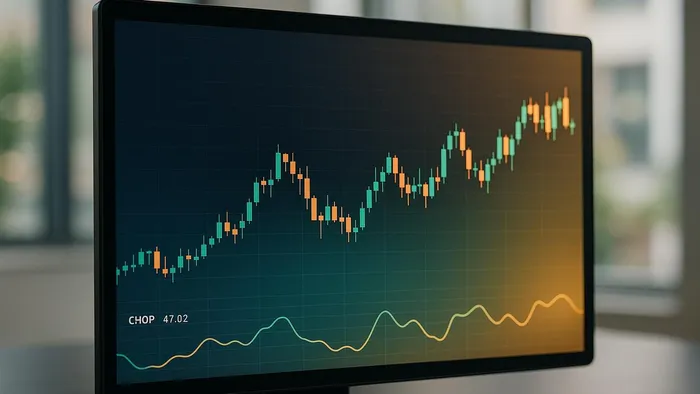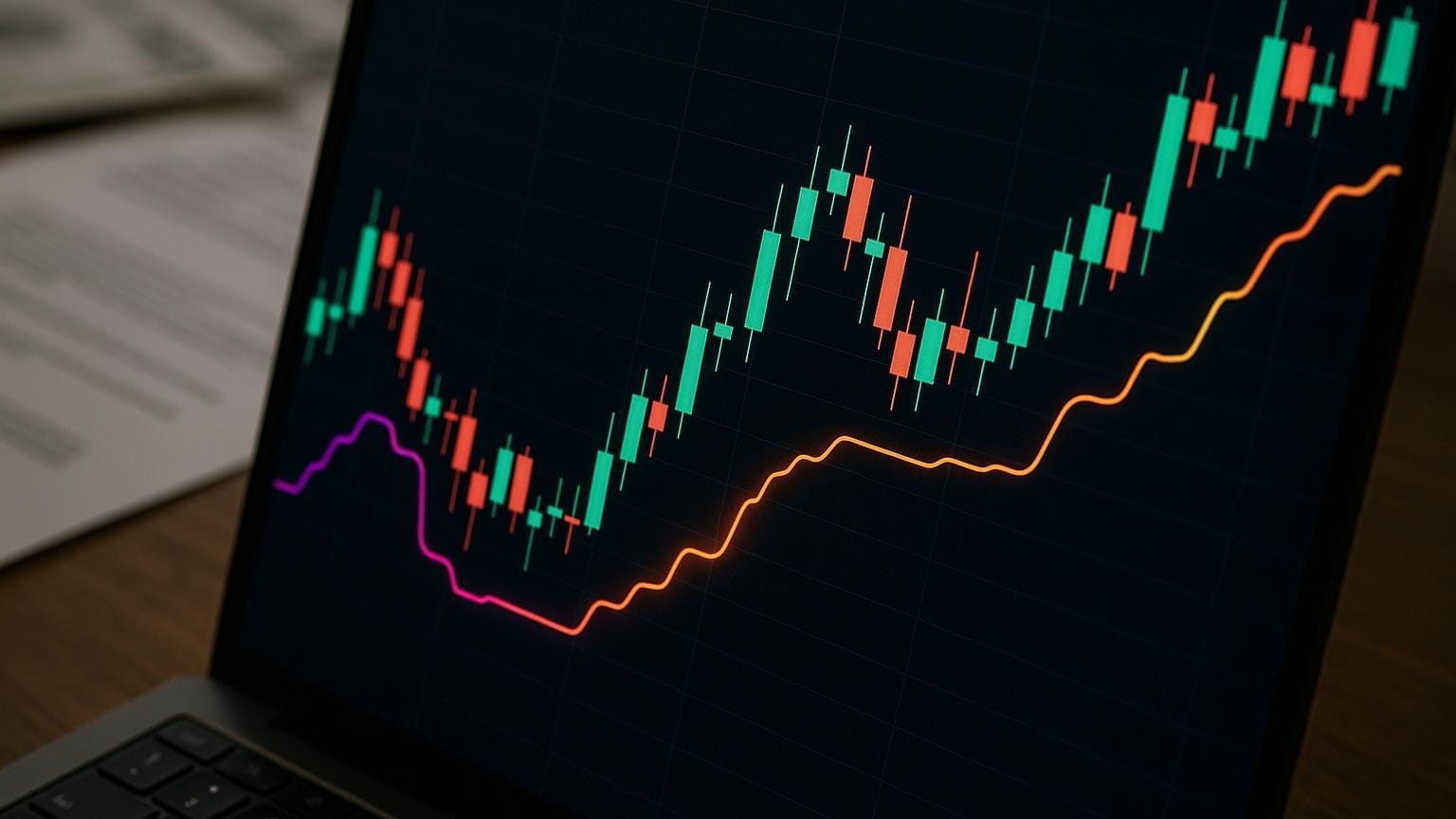Learn how the Choppiness Index helps traders assess market trends and consolidations, enhancing trading strategies with effective insights.
The Choppiness Index is a technical tool that helps traders quickly determine if a market is trending or moving sideways. It doesn’t predict price direction but quantifies market efficiency on a scale from 0 to 100:
- Low values (<38.2): Indicate a strong trend (up or down).
- High values (>61.8): Suggest a sideways, consolidating market.
- Mid-range (38.2–61.8): Represents transition phases.
This indicator is widely used across stocks, forex, commodities, and crypto to fine-tune strategies like trend-following or range-trading. While it simplifies market phase identification, pairing it with tools like moving averages or RSI can improve decision-making. Keep in mind, it doesn’t provide directional cues and can lag during rapid market shifts.
For U.S. traders, focus on liquid assets during regular market hours (9:30 AM–4:00 PM EST) for better reliability. Consider the official NYSE trading hours and calendars when planning entries around holidays or shortened sessions.
The Choppiness Index Indicator: Tutorial
How to Calculate and Read the Choppiness Index
Understanding the math behind the Choppiness Index helps clarify why it's so effective in analyzing varying market conditions. While most trading platforms calculate it for you, knowing the formula can give you a deeper understanding of what the indicator measures.
Choppiness Index Formula
The Choppiness Index relies on a formula that combines Average True Range (ATR), the highest and lowest prices over a period, and logarithmic scaling to generate a score between 0 and 100.
Choppiness Index = 100 × LOG10 [SUM(ATR(1), n) / (MaxHigh(n) − MinLow(n))] / LOG10(n)
Here’s a breakdown of the components:
- SUM(ATR(1), n): The sum of the Average True Range values over the selected period (commonly 14 days).
- MaxHigh(n): The highest price during the period.
- MinLow(n): The lowest price during the period.
- n: The number of days in the chosen period (typically 14).
- LOG10: A logarithmic function that scales the result to fit a 0–100 range.
The ATR measures price volatility by calculating the greatest value among three scenarios: today’s high minus today’s low, today’s high minus yesterday’s close, or today’s low minus yesterday’s close[4]. This ensures the index accounts for true volatility, including any gaps between sessions.
For example, if Apple’s stock reaches a high of $150.00 and a low of $130.00, and the 14-day ATR sum equals $35.00, the Choppiness Index would be approximately 21.2, indicating strong trending conditions:
Choppiness Index = 100 × LOG10(35 / (150 − 130)) / LOG10(14)
= 100 × LOG10(35 / 20) / LOG10(14)
= 100 × LOG10(1.75) / LOG10(14)
= 100 × 0.243 / 1.146
≈ 21.2
Now that we’ve covered the formula, let’s explore how to interpret the Choppiness Index on its 0–100 scale.
Reading the 0-100 Scale
The Choppiness Index operates on a scale from 0 to 100, with each value offering insights into market behavior. Lower values suggest a strong trend in either direction, while higher values point to a market stuck in a sideways or consolidating phase[1][2][3][5].
Traders often use specific thresholds to interpret the readings:
- Below 38.2: Indicates a trending market, whether upward or downward.
- Between 38.2 and 61.8: Suggests neutral or indecisive market conditions.
- Above 61.8: Reflects a choppy, consolidating market with minimal directional movement.
These thresholds are tied to Fibonacci retracement levels[1][3][5]. For background on how traders commonly use these ratios, see this overview of Fibonacci retracements.
When the Choppiness Index hovers around 50, it signals a neutral market with no clear trend. This often occurs during transition periods when the market is shifting between trending and consolidating phases[2].
What the Numbers Tell You
Real-time Choppiness Index readings allow traders to identify the market’s current phase and adjust their strategies accordingly. Trending markets show decisive price movements, while consolidating markets are marked by erratic reversals. The indicator helps traders align their approach with these conditions.
- High readings above 61.8: Suggest a sideways market with frequent reversals and limited net movement. This environment is ideal for range-trading or mean-reversion strategies, but trend-following systems often struggle during these periods[2][3][5].
- Low readings below 38.2: Indicate strong directional movement, favoring trend-following or momentum-based strategies, regardless of whether prices are rising or falling[2][3][5].
The default 14-day setting works well for most scenarios, but you can adjust the period to fine-tune the indicator’s sensitivity. Shorter periods (e.g., 10 days) make it more responsive to recent price action, while longer periods (e.g., 21 days) smooth out short-term fluctuations and highlight broader trends[4][5].
It’s important to note that the Choppiness Index does not predict market direction. A low reading confirms trending conditions but doesn’t indicate whether the trend is up or down. Similarly, a high reading signals consolidation but doesn’t tell you when it will end[1].
For U.S. traders working with stocks, ETFs, or futures, most platforms automatically handle dollar pricing and standard date formatting (MM/DD/YYYY). The decimal-based calculations align with U.S. market conventions, making it easy to interpret the indicator’s results[2][4].
How to Use the Choppiness Index in Trading
The Choppiness Index is more than just a number — it’s a tool that can help traders make smarter decisions about when to enter, exit, or even stay out of the market. By interpreting its readings in the context of real market conditions, traders can align their strategies with the rhythm of the market.

Spotting Market Phases
One of the key strengths of the Choppiness Index is its ability to highlight market phases early, giving traders a chance to prepare for what’s ahead.
- High readings (above 61.8): These suggest the market is in a consolidation phase, with prices bouncing between support and resistance levels.
- Low readings (below 38.2): These indicate the market is transitioning into a trending phase, where prices start moving in a clear direction.
The range between 38.2 and 61.8 acts as a transition zone. If the index starts moving from higher to lower readings within this zone, it could signal the end of consolidation and the start of a new trend. Recognizing these shifts early can help traders time their entries and exits more effectively.
Building Trading Strategies
Once you’ve identified the market phase, the next step is to tailor your trading strategy to fit. Misaligning your approach with the market’s behavior can increase risk, but syncing your strategy with the current phase can improve your chances of success.
- High Choppiness Index readings (above 61.8): These are ideal for range-trading strategies or specific options plays that thrive in sideways markets.
- Low Choppiness Index readings (below 38.2): These favor momentum-based strategies and trend-following trades. If you use ADX to confirm trend strength, here’s a concise primer on the Average Directional Index.
For markets stuck in the middle range (38.2 to 61.8), decision-making becomes trickier. During these phases, traders might consider scaling back position sizes or waiting for clearer signals. The Choppiness Index can also help guide position sizing, especially in volatile or uncertain conditions, to keep risk in check.
Pairing with Other Indicators
While the Choppiness Index is excellent for identifying market phases, it doesn’t provide directional cues. That’s why pairing it with other indicators can add clarity and confidence to your trading decisions.
- Moving Averages: These are particularly useful in trending markets. For example, when the Choppiness Index is low, moving average slopes or crossovers can help confirm whether the trend is upward or downward.
- Momentum Indicators (RSI, MACD): These can validate market phases further. In trending markets, RSI divergences might hint that the trend is losing steam. In choppy markets, RSI readings near extremes could signal reversal opportunities. For a refresher on MACD mechanics, see MACD explained.
- Bollinger Bands: These work well for timing entries and exits. In choppy markets, prices often oscillate between the bands, while a band squeeze during low Choppiness Index readings might signal an impending breakout. Read more about Bollinger Bands.
Most traders find that using the Choppiness Index alongside two or three complementary indicators strikes the right balance. This approach helps streamline decision-making, especially during U.S. market hours (9:30 AM to 4:00 PM EST), when trading activity and volatility are at their peak.
Choppiness Index with LuxAlgo Tools

The Choppiness Index is a handy tool for identifying market phases, but it has one major drawback — it doesn’t offer directional bias. This is where LuxAlgo provides additional clarity and insights to make trading decisions more confident and precise. By combining the Choppiness Index with LuxAlgo’s exclusive tools, traders can tackle common challenges like lagging signals and false positives, enhancing their overall market analysis.
Let’s dive into how LuxAlgo’s tools elevate the Choppiness Index for better trading outcomes.
\LuxAlgo provides the Choppiness Index as part of its free Library, which includes hundreds of indicators across popular platforms like TradingView, NinjaTrader, MetaTrader, and ThinkorSwim. The real advantage comes from pairing the Choppiness Index with LuxAlgo’s exclusive toolkits for a more unified market analysis.
- The Oscillator Matrix Toolkit addresses the directional limitations of the Choppiness Index. For instance, when the index dips below 38.2 — indicating a trending market — the Oscillator Matrix can confirm trend strength by detecting divergences in real time and providing money flow data.
- During consolidation periods, when the index rises above 61.8, the Signals & Overlays Toolkit helps by pinpointing support and resistance within the choppy range, making range-trading strategies more accurate.
Both toolkits also feature screeners that filter assets based on Choppiness Index readings across multiple timeframes. This saves time by quickly identifying whether an asset is trending or consolidating, eliminating the need for manual chart analysis.
AI Backtesting for Better Results
LuxAlgo’s AI Backtesting Assistant is a web platform that helps create and evaluate Choppiness Index strategies across assets and timeframes. It systematically tests variations in thresholds and lookback periods and can measure performance with metrics such as win rate, drawdown, and profit factor.
- The backtesting engine explores threshold levels beyond the standard 38.2 and 61.8 readings. For volatile stocks, thresholds like 35 and 65 may be more robust.
- It also fine-tunes the lookback period for Choppiness Index calculations, improving responsiveness to market changes.
The platform also tests combination strategies where the Choppiness Index is paired with other LuxAlgo indicators, analyzing performance metrics and surfacing candidates through weekly scans that match your criteria.
Benefits of LuxAlgo Integration
LuxAlgo offers several features that enhance the Choppiness Index and streamline trading:
- A custom alert system notifies traders when assets move between trending and choppy phases, based on specific Choppiness Index thresholds. Alerts can be tailored with criteria from other LuxAlgo tools so you only act on higher-probability signals.
- Real-time optimization helps keep your Choppiness Index settings effective during periods of shifting volatility (e.g., earnings season or major news).
- A community-driven approach allows access to strategies shared by other traders who use the Choppiness Index within LuxAlgo’s framework.
- For U.S. traders operating during market hours (9:30 AM–4:00 PM EST), LuxAlgo offers support resources and documentation to reduce downtime during critical sessions.
Limitations and Trading Tips
The Choppiness Index can be a helpful tool for understanding market consolidation, but it's not without its flaws. To use it effectively, traders need to be aware of its shortcomings and adjust their strategies accordingly.
What the Choppiness Index Cannot Do
One of the key limitations of the Choppiness Index is that it doesn't predict price direction. While it can indicate whether the market is trending or consolidating, it won't tell you if prices are likely to go up or down, leaving traders to make that determination themselves.
Another issue is its susceptibility to false signals, especially during periods of high volatility or rapid market changes. In sideways markets, frequent intraday reversals can produce multiple misleading readings, which can lead to unnecessary trades and increased costs.
Additionally, the Choppiness Index relies on historical price data, which means it often lags behind real-time market movements. By the time it confirms a trend, the most profitable part of the move might already be over, particularly in fast-moving markets.
Recognizing these limitations is the first step toward refining your approach. Here are some practical tips to help you navigate these challenges.
Tips for Better Results
- Use multiple timeframes: Combining different timeframes can provide a more complete view of market conditions. For example, if a short-term chart shows consolidation but a longer-term chart indicates a trend, waiting for alignment can help reduce noise and improve decision-making.
- Confirm signals with volume: A trending signal becomes more reliable when accompanied by above-average trading volume. For instance, if a stock shows a trending signal and volume is significantly higher than usual, the trend is more likely to hold.
- Practice strict risk management: Always use stop-loss orders to limit potential losses and avoid risking too much capital on a single trade. While the Choppiness Index can help identify market phases, it won't protect you from unexpected events or sudden price gaps.
- Wait for price action confirmation: To counteract the indicator's lag, look for confirmation from price movements. For example, a trending signal is more compelling when paired with a breakout above resistance and strong volume. Similarly, consolidation signals gain credibility when prices respect established support and resistance levels.
- Adjust position sizes based on conditions: In choppy markets, consider reducing your position sizes, as breakouts are less reliable. In trending markets, standard sizing can be used, but always pair it with careful stop-loss management.
Notes for U.S. Traders
For U.S. traders, there are a few additional considerations to keep in mind when using the Choppiness Index:
- Stick to regular trading hours: The indicator tends to be more reliable during regular market hours (9:30 AM–4:00 PM EST) when liquidity and participation are higher. Pre-market and after-hours sessions often produce misleading signals due to lower volume and wider spreads.
- Focus on liquid assets: Large-cap stocks, major ETFs, and widely traded securities generally provide cleaner and more reliable data compared to smaller or less liquid assets.
- Consider sector rotation: Different sectors may exhibit varying market conditions. While one sector may be trending, another could be consolidating. Always analyze the indicator within the broader context of market cycles and economic trends. A quick primer on the concept is here: sector rotation explained.
- Account for market holidays and shortened sessions: Reduced trading volume during holidays or shortened trading days can distort signals. Adjust your strategies accordingly during these times to avoid misinterpreting the data. Check official NYSE calendars when planning.
- Use Eastern Time for consistency: When backtesting or comparing strategies with other traders, stick to Eastern Time to align with U.S. market operations and ensure uniformity in your analysis and alerts.
Conclusion
The Choppiness Index is a handy tool for distinguishing between trending and consolidating markets. It evaluates price movement efficiency on a scale from 0 to 100, helping traders understand whether the market is showing directional momentum or moving sideways.
Here’s how to interpret it: readings above 61.8 indicate consolidation (not ideal for breakout strategies), while values below 38.2 point to trending conditions (better suited for momentum trades). The middle range represents a transition phase between these two states.
To get the most out of the Choppiness Index, it’s wise to pair it with other tools like volume analysis, price confirmation, and solid risk management practices. This layered approach helps offset its limitations, such as lagging signals and vulnerability to inaccuracies during highly volatile periods.
For U.S. traders, focusing on liquid, large-cap assets during regular trading hours (9:30 AM–4:00 PM EST) can enhance the reliability of signals. Incorporating broader factors like sector rotation and market cycles can also provide a deeper context for interpreting the readings.
While the Choppiness Index won’t predict price direction or eliminate false signals entirely, it offers useful insights into market conditions. When combined with disciplined execution, proper position sizing, stop-loss strategies, and confirmation from other indicators, it becomes a valuable tool for navigating both trending and consolidating markets effectively.
FAQs
How can traders use the Choppiness Index with other indicators to make better trading decisions?
Traders can make more informed decisions by using the Choppiness Index alongside other indicators. For instance, combining it with trend-following tools like Moving Averages or the ADX can help confirm whether the market is in a trend or stuck in a consolidation phase. This pairing can refine the timing of both entries and exits.
Another effective approach is using the Choppiness Index with oscillators like the MACD. This duo can highlight momentum shifts or signal potential reversals, giving traders a clearer view of high-probability setups while reducing the chances of false signals. By blending these tools, traders can better navigate shifting market conditions, improving precision and managing risk more efficiently.
What mistakes should traders avoid when using the Choppiness Index?
When using the Choppiness Index, traders often stumble by relying on it alone. While it's a helpful tool, it truly shines when paired with other technical indicators. Combining it with additional tools can confirm signals and offer a more complete view of market dynamics. Leaning on it as the sole decision-maker can lead to avoidable mistakes.
Another common pitfall is misunderstanding high or low readings without factoring in the bigger picture. For example, a high Choppiness Index reading doesn’t automatically signal that the market will consolidate right away. Similarly, a low reading doesn’t always mean a strong trend is imminent. It’s essential to consider the broader market context to avoid jumping into trades too early or exiting too soon.
By blending the Choppiness Index with other analytical methods and keeping a close eye on market conditions, traders can make decisions with greater confidence and precision.
How does the Choppiness Index respond to volatile or rapidly changing market conditions?
The Choppiness Index measures whether the market is consolidating or trending, even when conditions are volatile or shifting quickly. When volatility picks up, the index typically climbs, indicating a more erratic or indecisive market. Higher readings (like above 61.8) generally point to consolidation, while lower readings suggest the market is trending.
Traders often rely on this tool to gain insight into market behavior, identify potential trend reversals, or prepare for uncertain periods. It’s a handy resource for making sense of unpredictable market movements.
References
LuxAlgo Resources
- LuxAlgo — Official Site
- AI Backtesting Assistant
- Understanding Moving Averages
- Trending Market Toolkit
- Support & Resistance (Dynamic)
- Opening Range with Breakouts & Targets
- RSI Candlestick Oscillator
- Money Flow Profile
- Historical Price Projection
- Volume Forecasting
- Volumetric Toolkit
- Market Structure Intrabar
- Oscillator Matrix — Reversal Signals (Docs)
- Oscillator Matrix — Reversal Signals (Docs Variant)
- Average True Range (overview)
External Resources
- TradingView — Choppiness Index
- Angel One — Choppiness Index
- Quantified Strategies — Choppiness Index
- TrendSpider — Choppiness Index
- Morpher — Choppiness Index
- Investopedia — Fibonacci Retracements
- Investopedia — Average Directional Index (ADX)
- Investopedia — MACD
- Investopedia — Bollinger Bands
- NYSE — Hours & Calendars
- TradingView — Charting Platform
- NinjaTrader — Platform
- MetaTrader 5 — Platform
- thinkorswim by Schwab








